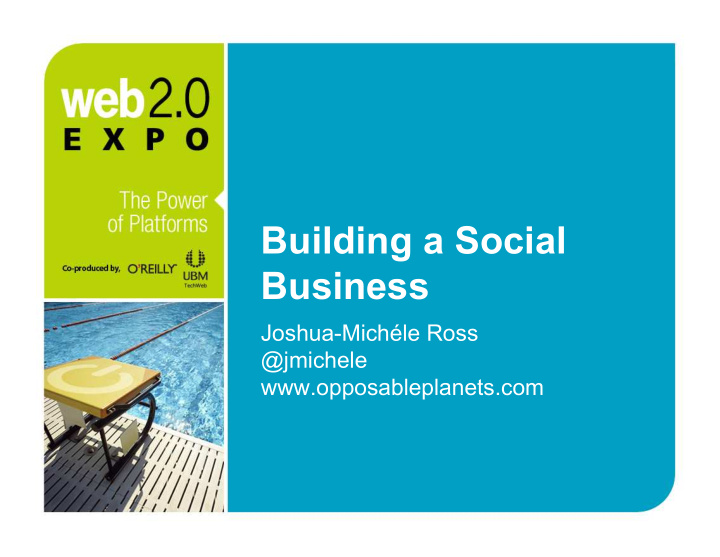



Building a Social Business Joshua-Michéle Ross @jmichele www.opposableplanets.com
Why Social Business? What is Social Business? How are Organizations Doing It?
“If You Are in Business You’ve Got Problems” -David Burk
The Real-Time News Cycle 15+ WSJ Print MIL. 10+ MIL. INFLUENCE 5 MIL. 1 MIL. 5:30 PM 5:30 PM 12:00 AM Day One Day Two TIME
The Real-Time News Cycle 15+ CNET.com NYTimes.com CNN.com AP.com WSJ Print MIL. 10+ MIL. INFLUENCE 5 MIL. 1 MIL. 5:30 PM 5:30 PM 12:00 AM Day One Day Two TIME
You Always Have Other Options
78% 14% Only of of people trust people trust the advertisements recommendaOons of their peers { One-Way } { Conversation } Nielsen, “Trust in Advertising” Oct. 2007
Very high/ High % Nurses 84 Druggists, pharmacists 73 Veterinarians 71 Medical doctors 69 Dentists 62 Engineers 61 Clergy 58 College teachers 58 Policemen 54 Psychiatrists 38 Bankers 37 Chiropractors 36 Journalists 26 State governors 22 Business executives 18 Lawyers 18 Stockbrokers 17 Senators 15 Congressmen 14 Insurance salesmen 13 HMO managers 12 Advertising practitioners 11 Car salesmen 7 Gallup Poll . Dec. 8-10, 2006. N=1,009 adults USA nationwide. MoE ± 3. 11 11
o Armed forces +43% o NGOs +27% o Educa7on system +26% o Health system +17% o Trade unions/labor +2% o Legal system ‐2% o Global companies ‐9% o Large na7onal companies ‐10% Accenture The Business of Trust , World Economic Forum “Voice of the People Forum” * Net Ra7ng = % trust ‐ % distrust 12
Shifts in Media Habits The communications landscape has changed as a result of social media and the growth is exponential 2009 Statistics: • More than 70 million videos on YouTube • Over 133,000,000 blogs indexed on Technorati • 1.7 billion tweets on Twitter • 400 million + users on Facebook representing 170 countries/territories • Dramatic decline in newspaper circulation 14 14
Closed Newspapers: 2007 15
Closed Newspapers: 2007-2008 16
Closed Newspapers: 2007-2009 17
The time spent / ad spend gap Ad Spend Media Time Online Radio 100% Magazines Online 80% Newspapers Radio 60% Magazines Newspapers Television 40% 20% Television Other Source: eMarketer, Forrester Research; ZenithOp7media; Marketspace Analysis
“No Flash Ads. No Banner ads. No pre- roll video ads. Make an awesome product and then find online communities that would like your product and become a member of that community. Allow the community to have conversations about your product or service and welcome the input.” Ethan Bodner – 17 – High School Senior (2007)
The Internet is not disruptive because it shifts business models… It is disruptive because it shifts mental models…
Analog Digital books, newspapers, music, movies communications, commerce… Slides 11-18 adapted from Richard Wiley’s fantastic Slideshare presentation on open education
Isolated Networked people, content, devices, systems
Tethered Mobile everything is connected workforce replaces workplace
Closed Open journalism, software, hardware, innovation
Subjects Verbs creators, publishers, critics, citizen journalists…
From To Analog Digital Isolated Networked Tethered Mobile Closed Open
Past Future Analog Digital Isolated Networked Tethered Mobile Closed Open
Business Social Business Analog Digital Isolated Networked Tethered Mobile Closed Open
This marks the end of civilization
Credit: Richard Wiley
How do I stop these people? Flickr: pacoalcantara
Is it Safe?
three key questions…
how do I align employee talent with organizational mission? who “owns” social media and how do you “run” it? how do I measure a social business?
all answers are provisional no one is getting everything right proceed with more humility than caution
Marketing Communications Product Development Human Resources Legal IT
Guidelines Framework CODE OF CONDUCT GENERAL GUIDELINES— All Employees Getting Engaged (Action Steps and Best Practices) OFFICIAL GUIDELINES— Employee Reps Training and Certification Brand-Specific Extensions
Who “owns” Social Media?
Who Wants the opportunity? Who has a Mandate from top management? Who has core competency that aligns with social business objectives? Who is fittest to collaborate
How do you “run” it? Distributed Centralized Blended The Distributed Model • Let 1000 Flowers Bloom • All departments practice social media. Business unit and department executives leverage social channels. Based on http://adage.com/digital/article?article_id=142221
Three Models of Governance Distributed Centralized Blended The Centralized Model • Executive sponsor leads. Goals, policies, guidelines, and investments are convened by a chair. • Suitable in regulated industries, cultures with more formal hierarchy
Three Models of Governance Distributed Centralized Blended The Blended Model • Gives authority to the “edge” of the organization to engage the world • Provides some central planning and guidance
measurement is costly measurement is cultural some things can never be measured
Don’t say ROI unless you mean it ROI is a financial metric. Must take one of three forms: • Revenue generated • Cost savings • Cost avoidance
Consider Value Creation… Value is an investment that eventually may be ‘cashed in’ as ROI. It is both tangible and intangible. • Create awareness • Increase purchase consideration • Enhance brand strength • Improve reputation
Measurement, Research and Planning CommunicaOons Model Business Business Research Key Metrics Objectives Process Approach Exposure Engagement Influence Action Addressed Increase share of Reputation Media Net Positive X positive coverage monitoring OTS from 15 to 25% by and content year-end 2010 analysis Reproduced with permission from Don Bartholomew – metricsman.wordpress.com
Q&A @jmichele
Recommend
More recommend